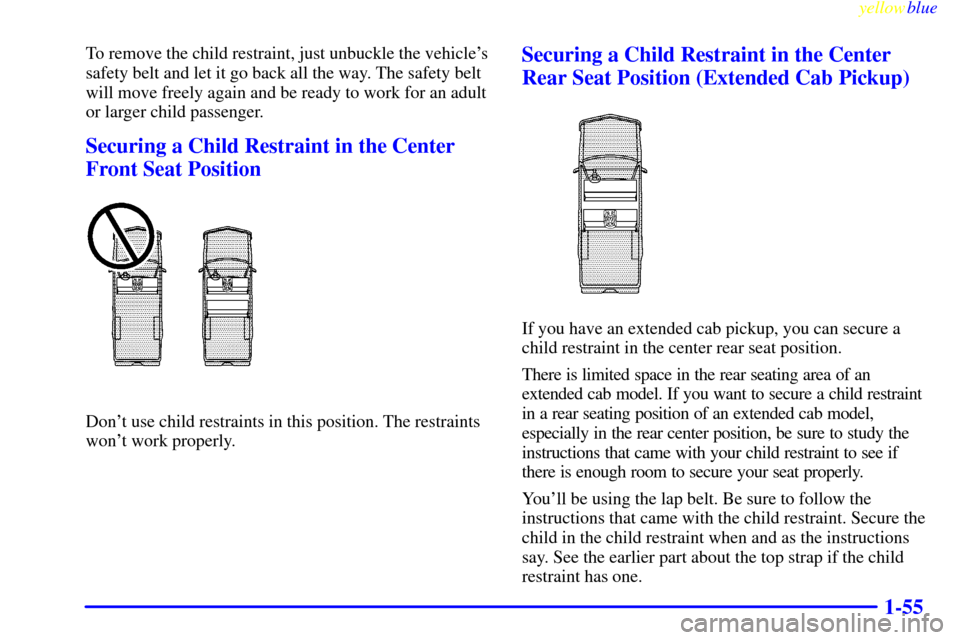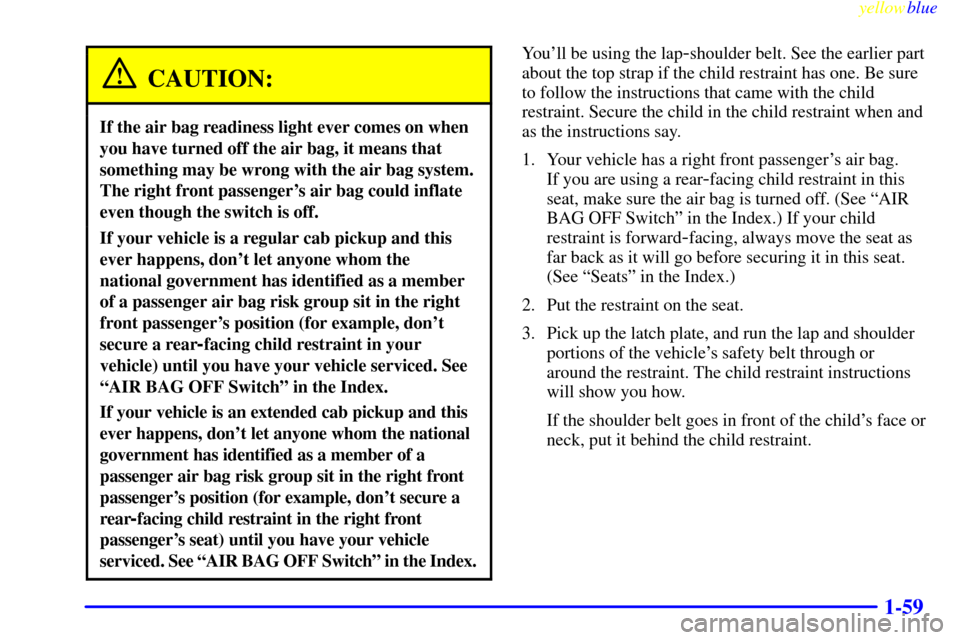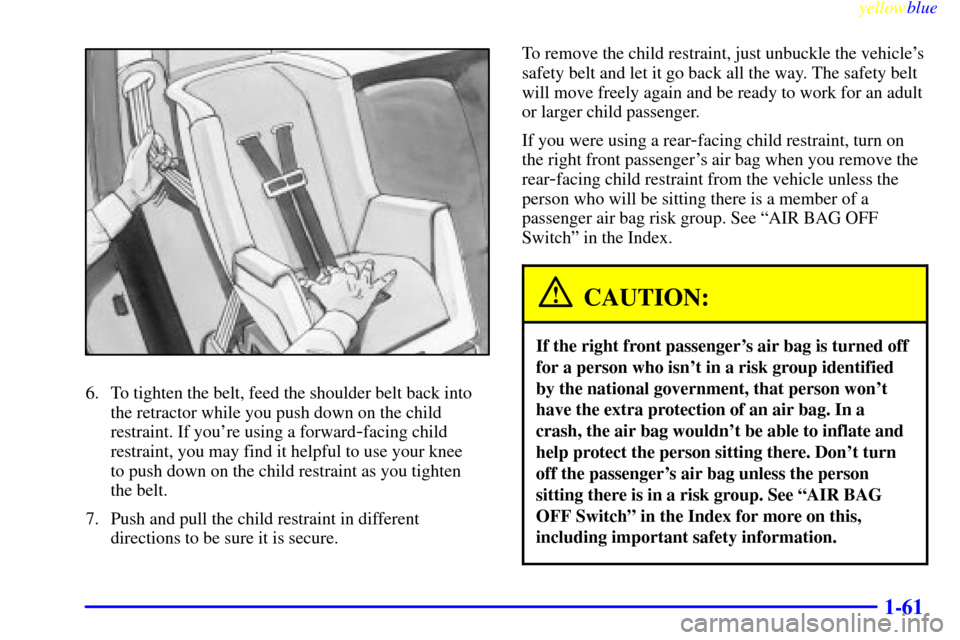Page 67 of 421

yellowblue
1-55
To remove the child restraint, just unbuckle the vehicle's
safety belt and let it go back all the way. The safety belt
will move freely again and be ready to work for an adult
or larger child passenger.
Securing a Child Restraint in the Center
Front Seat Position
Don't use child restraints in this position. The restraints
won't work properly.
Securing a Child Restraint in the Center
Rear Seat Position (Extended Cab Pickup)
If you have an extended cab pickup, you can secure a
child restraint in the center rear seat position.
There is limited space in the rear seating area of an
extended cab model. If you want to secure a child restraint
in a rear seating position of an extended cab model,
especially in the rear center position, be sure to study the
instructions that came with your child restraint to see if
there is enough room to secure your seat properly.
You'll be using the lap belt. Be sure to follow the
instructions that came with the child restraint. Secure the
child in the child restraint when and as the instructions
say. See the earlier part about the top strap if the child
restraint has one.
Page 68 of 421
yellowblue
1-56
1. Make the belt as long as possible by tilting the latch
plate and pulling it along the belt.
2. Put the restraint on the seat.3. Run the vehicle's safety belt through or around the
restraint. The child restraint instructions will show
you how.
4. Buckle the belt. Make sure the release button is
positioned so you would be able to unbuckle the
safety belt quickly if you ever had to.
Page 69 of 421
yellowblue
1-57
5. To tighten the belt, pull its free end while you push
down on the child restraint. If you're using a
forward
-facing child restraint, you may find it
helpful to use your knee to push down on the child
restraint as you tighten the belt.
6. Push and pull the child restraint in different
directions to be sure it is secure.
To remove the child restraint, just unbuckle the vehicle's
safety belt. It will be ready to work for an adult or larger
child passenger.
Securing a Child Restraint in the Right
Front Seat Position
Your vehicle has a right front passenger air bag. There's
a switch on the instrument panel that you can use to turn
off the right front passenger's air bag when you want to
secure a rear
-facing child restraint at the right front
passenger's position. See ªAIR BAG OFF Switchº
in the Index for more on this, including important
safety information.
Page 71 of 421

yellowblue
1-59
CAUTION:
If the air bag readiness light ever comes on when
you have turned off the air bag, it means that
something may be wrong with the air bag system.
The right front passenger's air bag could inflate
even though the switch is off.
If your vehicle is a regular cab pickup and this
ever happens, don't let anyone whom the
national government has identified as a member
of a passenger air bag risk group sit in the right
front passenger's position (for example, don't
secure a rear
-facing child restraint in your
vehicle) until you have your vehicle serviced. See
ªAIR BAG OFF Switchº in the Index.
If your vehicle is an extended cab pickup and this
ever happens, don't let anyone whom the national
government has identified as a member of a
passenger air bag risk group sit in the right front
passenger's position (for example, don't secure a
rear
-facing child restraint in the right front
passenger's seat) until you have your vehicle
serviced. See ªAIR BAG OFF Switchº in the Index.
You'll be using the lap-shoulder belt. See the earlier part
about the top strap if the child restraint has one. Be sure
to follow the instructions that came with the child
restraint. Secure the child in the child restraint when and
as the instructions say.
1. Your vehicle has a right front passenger's air bag.
If you are using a rear
-facing child restraint in this
seat, make sure the air bag is turned off. (See ªAIR
BAG OFF Switchº in the Index.) If your child
restraint is forward
-facing, always move the seat as
far back as it will go before securing it in this seat.
(See ªSeatsº in the Index.)
2. Put the restraint on the seat.
3. Pick up the latch plate, and run the lap and shoulder
portions of the vehicle's safety belt through or
around the restraint. The child restraint instructions
will show you how.
If the shoulder belt goes in front of the child's face or
neck, put it behind the child restraint.
Page 72 of 421
yellowblue
1-60
4. Buckle the belt. Make sure the release button is
positioned so you would be able to unbuckle the
safety belt quickly if you ever had to.5. Pull the rest of the shoulder belt all the way out of
the retractor to set the lock.
Page 73 of 421

yellowblue
1-61
6. To tighten the belt, feed the shoulder belt back into
the retractor while you push down on the child
restraint. If you're using a forward
-facing child
restraint, you may find it helpful to use your knee
to push down on the child restraint as you tighten
the belt.
7. Push and pull the child restraint in different
directions to be sure it is secure.To remove the child restraint, just unbuckle the vehicle's
safety belt and let it go back all the way. The safety belt
will move freely again and be ready to work for an adult
or larger child passenger.
If you were using a rear
-facing child restraint, turn on
the right front passenger's air bag when you remove the
rear
-facing child restraint from the vehicle unless the
person who will be sitting there is a member of a
passenger air bag risk group. See ªAIR BAG OFF
Switchº in the Index.
CAUTION:
If the right front passenger's air bag is turned off
for a person who isn't in a risk group identified
by the national government, that person won't
have the extra protection of an air bag. In a
crash, the air bag wouldn't be able to inflate and
help protect the person sitting there. Don't turn
off the passenger's air bag unless the person
sitting there is in a risk group. See ªAIR BAG
OFF Switchº in the Index for more on this,
including important safety information.
Page 74 of 421
yellowblue
1-62
Larger ChildrenChildren who have outgrown child restraints should
wear the vehicle's safety belts.
If you have the choice, a child should sit next to a
window so the child can wear a lap
-shoulder belt and
get the additional restraint a shoulder belt can provide.
Accident statistics show that children are safer if they
are restrained in the rear seat. But they need to use the
safety belts properly.
�Children who aren't buckled up can be thrown out in
a crash.
�Children who aren't buckled up can strike other
people who are.
Page 75 of 421
yellowblue
1-63
CAUTION:
Never do this.
Here two children are wearing the same belt. The
belt can't properly spread the impact forces. In a
crash, the two children can be crushed together
and seriously injured. A belt must be used by
only one person at a time.
Q:What if a child is wearing a lap-shoulder belt,
but the child is so small that the shoulder belt is
very close to the child's face or neck?
A:Move the child toward the center of the vehicle, but
be sure that the shoulder belt still is on the child's
shoulder, so that in a crash the child's upper body
would have the restraint that belts provide. If the
child is sitting in a rear seat outside position, see
ªRear Safety Belt Comfort Guidesº in the Index.
If the child is so small that the shoulder belt is still
very close to the child's face or neck, you might
want to place the child in a seat that has a lap belt,
if your vehicle has one.